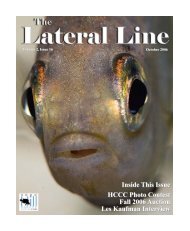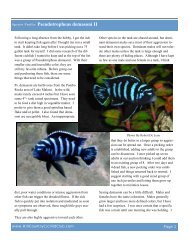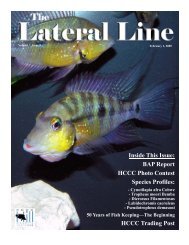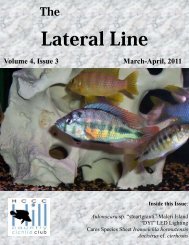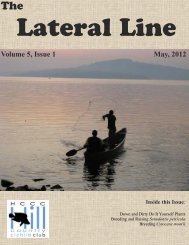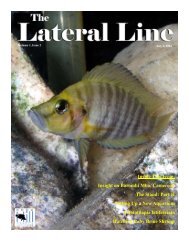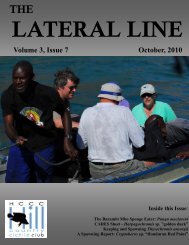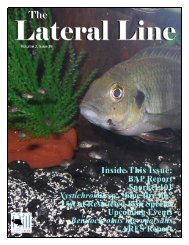Volume 2, Issue 42 November, 2009 - Hill Country Cichlid Club
Volume 2, Issue 42 November, 2009 - Hill Country Cichlid Club
Volume 2, Issue 42 November, 2009 - Hill Country Cichlid Club
You also want an ePaper? Increase the reach of your titles
YUMPU automatically turns print PDFs into web optimized ePapers that Google loves.
THELATERAL LINE<strong>Volume</strong> 2, <strong>Issue</strong> <strong>42</strong> <strong>November</strong>, <strong>2009</strong>Inside this <strong>Issue</strong>:What Do You really Know About the Edwards AquiferNew to the Hobby HaplochrominesBAP Year End ReportThe C.A.R.E.S Preservation Program and YouLamprologus calliurus ‘Magara’
One of the many outflows of the Edwards Aquifer System are the springs at PantherCanyon, the source of the Comal River in New Braunfels, Texas.What Do You Really Know About the Edwards Aquifer?Walter Wooton Jr.How many of us actually ever really thoughtabout the Edwards Aquifer? I know I neverdid. To me it was just a name and if it becameto low I couldn't water my lawn. Thisall changed while doing some research on theComal and San Marcos rivers. I found thatboth of these rivers are fed by the EdwardsAquifer. I was discussing the "finds" withGreg Steeves who suggested I put some ofthis down for all to see.The formation of the Edwards Aquifer startedback in the Paleozoic era around 500-600million years ago. During this time the areawe now call home was part of a sea and theGulf of Mexico was a mountain range. It wasthen that the limestone foundation was laidfor our little aquifer. Approximately 200 millionyears ago during the Mesozoic era, therewas a rather dramatic shift where the Gulf ofMexico began to sink and become covered bythe sea. What we now call Texas started tobecome dry land. This was a time of greatfluctuations where our local area was under ashallow sea at times and other times we weredry. The dry periods were times of extensiveerosion of the Edwards limestone layer thatwas laid during the Paleozoic era. Sometimeafter this towards the Cenozoic era around700 million years ago, the eroded limestonebegan to cover with varying materials butmainly what we now know as "Del RioClay". This earthen clay is comprised mainlyof wind driven ash from volcanoes on the Pacificcoast of Mexico. The clay was thenoverlaid with newer or younger limestone3
The beautiful Comal River is a direct outflow of the Edwards Aquifer.down to the recharge zone. When the watercollected in the contributing zone flows downthe streams and creeks across the rechargezone it not only flows down steam, but it alsoflows across and consequently down fissuresin the limestone beds. If you have ever seen acreek that is flowing great then just seems topeter out and then goes dry (Cibolo creek is agood example) and wondered why, this iswhat has happened. Sink holes are also use torecharge the aquifer by filling with rain waterwhich then percolates down into the aquifer.There are also millions of fissures all acrossthe recharge zone most we would never notice.These fissures act very similar to theones in the stream beds but the collect rainwater feeding it directly down into the aquiferor into an underground cavity that thenpercolates down into it.Now we have covered some of the very basics,allow me to share my thoughts with you.We are truly blessed to have such a simpleyet complex and highly productive watersource. It gives us its own barometer of itshealth even if we didn't have the J-17 wellmeasurements. When she is healthy and at ornear capacity, water flows from the San Antonioand San Pedro springs (sadly not inyears) and when she is being over used wesee diminished flows at San Marcos and Comalsprings. She gives us some of the cleanestwater of any municipality in the worldonly getting chlorine added instead of goingthrough a long and expensive purifying process.The trace mineral content and KH andpH are absolutely awesome for the fish andplants that we keep. It supports a diverse andvery unique set of species that we can call5
The pristine waters of the Edwards Aquifersupport a diverse assemblage of plantand animal life.our own. I am left wondering about the futureof such a great and wonderful treasure. Weare the 7th largest city in the U.S. With thatcomes many opportunities and challenges inmanaging this vital resource. We must all doour part in protecting it and not through overreaction but through our own responsible actions.Think of it this way, thanks to the wonderfulhydraulics of our aquifer the next glassof water you drink may be more then 200years old.Gabe's Fish and ExoticPetsa proud supporter of the HCCC15% off Livestockand most supplies5418 Glen RidgeSan Antonio, TX 78229(210) 290-9376Upcoming Events<strong>November</strong> 14thOKAA Tulsa Chapter Meeting<strong>November</strong> 15thHCCC Fall Auction<strong>November</strong> 21stOKAA Stillwater Chapter MeetingDecember 5thHCCC Christmas PartyAmazoniaInternationala proud supporter of the HCCCMember discounts:20% off Fish & Live Plants10% off Tanks, Stands, Eheims& Eclipses25% off Filters & Powerheads4631 Airport #116 Austin, TX(512) 451-0958December 12thTCA Christmas PartyJanuary 16thTCA Monthly MeetingLisa’s Lair BookstoreOnline BooksVarious Discounts forHCCC Memberswww.lisaslairbookstore.com6
Astatotilapia callipterus, Astsatotilapi bloyeti and Astatotilpia burtoni were among thefirst haplochromine cichlids imported to the North American hobby.New to the Hobby HaplochrominesGreg SteevesIn recent years, a sector of the cichlid hobbyhas rocketed in popularity. There is a growingawareness of a group of fish we refer toas ‘haplochromines”. This moniker has itsbasis in the 1888 description of Haplochromisobliquidens by evolutionary scientistFrans Hilgendorf. Although there aremany different lineages of cichlid fish, primarilyfrom East Africa, the term“haplochromis” has become a generic termused to depict a group of quickly evolvingmouth brooding cichlid fish that share commonancestry. Whether the interest stemsfrom the smaller size of the brightly coloredfish and their ability to so easily adapt to lifein our aquariums, or from the growingknowledge that many of these fish no longerexist in the wild and with each passing day,those remaining lose more and more of theirhabitat, one thing is certain, cichlid hobbyistswant these fish in their aquariums!Haplochromines are not “new” fish. Fortyyears ago Astatotilapia bloyeti, A. callipterus,and A. burtoni were available. In the 1950’s,Astatotilapia sp. “thick skin” (then erroneouslynamed Haplochromis obliquidens)found their way to the US. In the mid 1980’sexportation of Lake Victoria haplochromineswas well underway. A pioneer in this operationwas the Swedish collector Bo Selbrink.Ultimately, many of the fish found by Selbrinkin Lake Victoria, soon after fell victimto the Nile perch (Lates niloticus). Amongthe fish he incidentally saved from extinctionis Prognathochromis perrieri. This charminglittle piscivore exists only in captivity today.Sadly, many fish collected during this timeare now gone forever. Similar stories can betold of the Whitehead’s in the Kyoga Basin,Les Kaufman and the Lake Victoria SpeciesSurvival Plan (LV-SSP) in Lake Victoria’sUgandan waters, Paul Loiselle in Kenya’sYala Swamp, and the fish studied in theSouthern regions of Lake Victoria by theHaplochromis Ecological Study Team(HEST) and individuals such as Ole Seehausenand Yves Fermon. There have beenno frequent cichlid exports from the LakeVictoria region since the 1990’s.7
entire diverse group of fish from certain extinction.a proud supporter of the HCCC15% off total purchaseexcluding specials, package deals, and sale items12315 Wetmore Rd.San Antonio, TX 78247(210)653-8880www.petfrontier.comAstatotilapia sp. “thick skin” was amongthe first fish exported from the Lake Victoriaregion.Ironically, the lack of new wild stock into theaquatic hobby has had a positive impact onthe haplochromine cichlid fish that are maintainedin captivity. Many of us realize thatthere is no “going back to the well” for more.What we have is what there is. There hasbeen a concretive effort by the hobbyist tolearn all that is available, to propagate thesefish and establish as many colonies with asmany people that is possible. The success ofprograms such as C.A.R.E.S lies in the recognitionthat the hobbyist holds the last chanceat survival for many species. This is a taskthat is not taken lightly. There have beenmany recent success stories showing that theaverage hobbyist has what it takes to save anPrognathochromis perrieri, originally collectedin the 1980’s from Lake Victoria, isnow considered extinct in the wild.Now that we have an international network inplace to exchange information and cichlidspecies, haplochromines kept on one side ofthe Atlantic but not available on the other,moving fish is now an inconvenience, notimpossibility. Anton Lamboj has been responsiblefor establishing transportation networksand he himself has introduced manyfish species both from the wild and betweencontinents, to respective aquarists. His effortshave been a huge boost to the hobby aswell as to saving dwindling wild populationsLipochromis melanopterus from MakobeIsland Lake Victoria is a recent importfrom American and European exchanges.8
of cichlid species. We owe the recent establishmentof Astatotilapia desfontainii and Astatotilapiaflaviijosephi to Anton. He hasalso mentored people such as Ted Judy andEric Bodrock in the art of transporting fishinternationally. Through these avenues wenow have Lipochromis melanopterus,‘Haplochromis’ cyaneus, Harpagochromissp. “orange rock hunter” and ‘Haplochromis’thereuterion.Paralabidochromis sauvagei from MwanzaGulf Lake Victoria is a 2007 addition tothe hobby.‘Haplochromis’ thereuterion is beautifuland unusual cichlid from Lake Victoria.Another modern day aquatic explorer is agentleman named Lawrence Kent. Lawrencehas been able to reintroduce Psammochromisriponianus into the hobby. Together withCory Koch, an incredible cichlid breederfrom St. Louis, these two men have been ableto establish multiple colonies throughout theUS. There will quite possible be more tocome from this team in the near future.Mbipia mbipi is another Mwanza Gulf import.Psammochromis riponianus from EntebbeUganda.Lithochromis rufus from Mwanza is alwaysin high demand within the hobby. Mosthaplochromine fish are extremely colorful.9
AquaTek Tropical Fisha proud supporter of theHCCC10% off Fish8023 Burnet Rd. # 1fish collected for scientific purposes that, althoughcaptivity maintained for many years,have never been introduced to the hobby.Through the efforts of people such as PaulLoiselle, the aquarist will see new fish fromthese enterprises in the future.In 2007 a glimmer of hope occurred whenLaif Demason brought a good sized shipmentof fish in from the Mwanza Bay Lake Victoria.We were able to establish stable groupsof Mbipia mbipi, Paralabidochromis sauvagei,and Pundamilia nyererei from this.Hopefully we will see another sizeable wildimportation to come.In Germany Erwin Schraml has been able tobring back fish from his travels to Africa.Much as Lawrence has done in the US, Erwinhas done in Europe. Eventually, his discoveriesusually make it to the North Americanhobby.Lipochromis sp. “two stripe white lip” iscurrently maintained by AZA’s Lake VictoriaSpecies Survival Plan. Perhaps hobbyistswill soon get to work with this rarepaedophage.Pundamilia nyererei from Mwanza gulfwas an instant sensation with aquaristswhen first imported in 2007.Institutions and organizations such as HESTand the LVSSP sometimes, through unusuallycomplicated avenues, release excessstock from their reserves. These are oftenAstatotilapia desfontainii is another recentaddition to the cichlid hobby.Although there are hundreds of haplochrominecichlids that do not exist in theaquarium hobby, there is an attitude of urgencyin some cases to be able to “save”these fish from extinction in the wild bymaintaining them in captivity. Perhaps is itbetter to have new species trickle in. Maybea massive introduction of new cichlids would10
ANNOUNCING THE HCCCAstatotilapia flaviijosephi is a recent speciesto be added to the assemblage of beautifulhaplochromines now being bred by aquariumhobbyists.subdue the excitement of being able to workwith and display these new fish to others.Either way, it is more and more relevant thatthe responsibility of survival for many haplochrominefish lies with the cichlid hobbyist.Based on recent awareness and successes, Ihave a good feeling for the long term survivalof this entire assemblage of creatures.EVENT OF THE YEAR3636 Northwest Loop 410San Antonio, TX 78201Potluck DinnerRSVP only.See Members Section ofHCCC Discussion Forumfor details.Leslie’s Pool Supplya proud supporter of theHCCC20% off Pool Supplies5-20% off selected itemsAll LocationsGuest Speaker Ted JudyAwards presentation andChristmas auctionMembers and theirfamilies only!11
HCCC Leadership GroupRobert De LeonDave HansenJB EdmundsonDiane TennisonDan IrwinEvan BowersGreg SteevesHCCC WebmasterRobert DeLeonHCCC Database guruEvan BowersHCCC TreasurerDave HansenBarbara WootonTroy VeltropGreg SteevesHCCC Auction CoordinatorDan IrwinBox Exchange CommitteeDave SchumacherGreg SteevesHCCC Honorary Life MembersSpencer Jack 2004Robert De Leon 2006Anton Lamboj 2007Dave Hansen 2007HCCC MembershipDiane TennisonHCCC Meeting CoordinatorDan IrwinHCCC LibrarianTakeru GarciaHCCC Lateral Line EditorGreg SteevesHCCC BAP ChairmanDan SchachtHCCC CARES ChairmanTroy VeltropHCCC CARES CoordinatorBarbara WootonHCCC CARES/InternationalCARES CommitteeClaudia DickinsonDave HansenA special thank you to the following clubsupporters. Please keep these fine manufacturersin mind when visiting a club supportingstore.Koller CraftEco System Aquarium<strong>Cichlid</strong> News MagazineHydor USAZoo Med Labs.San Francisco Bay BrandRed SeaDrs. Foster & SmithTetraGinger Inc.Omega Sea<strong>Cichlid</strong> PressCentral Aquatics12
BAP ReportDan SchachtThe BAP program was a great success andasset to the club this year. <strong>Club</strong> memberscame out and donated more than 100 differentitems into the club ranging from fry donationsto parent donations and the greatest ofall, articles! The fish spawned this year inthe club have a geographic range from Africato the American continents. All in all, almost2000 points were earned this year by differentmembers of the club!Thank you everyone who donated of yourtime and fish. The hobby is a better placewith you than without!There are some changes to the BAP rules tohelp clarify certain aspects of the point awardsystem. Only one rule modification actuallyaffects the amount of points you can earn.Starting <strong>November</strong> 1 st , all articles that aresubmitted and published in the Lateral Linewill be awarded 10 points, regardless whetheror not the fish spawned was a first of speciesor not. For the exact wording and rules,please visit the <strong>Hill</strong> <strong>Country</strong> <strong>Cichlid</strong> <strong>Club</strong>website under the BAP section.BAP Year Standings310 Nick240 Greg230 JB185 Evan170 Dan S.125 Barbara125 Dan I.115 Ben70 Tony65 Jim50 Matt45 Allen45 Mike40 Dave S.35 Dave H.30 Tony B.25 Robert D.25 Brenda15 Tak15 Robert T.15 Jim (petfrontier)15 Ken5 JenniferThanks everyone for the great year and let’s“Do it again in 2010!”13
IsThe <strong>Hill</strong> <strong>Country</strong> <strong>Cichlid</strong> <strong>Club</strong>pleased to promote our relationshipwith Zoo Med Laboratories Inc.We are all fortunate to benefit byZoo Med’s outstanding contribution tothe aquarium hobbyZoo Med products can be found at the following HCCC supporters:Amazonia International, Austin TXGabe’s Fish and Exotic Pets, San Antonio TXDarby’s Tropicals, New Braunfels TXPet Frontier, San Antonio TXAquatek, Austin TXDave’s Rare Aquarium Fish, San Antonio TX14
What is the C.A.R.E.S. PreservationProgram and What Can You do to HelpMake a Difference?Troy VeltropA CARES species only aquarium specifically created to house H. sp. “ruby”.The C.A.R.E.S. Preservation Program is thevision of Claudia Dickinson and was foundedin 2004. The "parent organization" to allC.A.R.E.S. member clubs, it offers to fishclubs across the US and Canada, a chance toimplement the C.A.R.E.S. program into theirclubs. The C.A.R.E.S. Preservation Programnot only includes cichlids but also includesanabantids, catfish, cichlids, killifish, livebearers,loaches, rainbowfish, and otherfreshwater fish. Not to mention quite a fewseahorses so both freshwater and marineclubs can implement the program. Today,many people are volunteers in the C.A.R.E.S.effort and without their contributions, past,present, and future, none of this would bepossible. Please visitwww.CaresPreservation.com for more information.Even before we started HCCC CARES, severalof our members have been hard at workfor the C.A.R.E.S. effort. You all know GregSteeves, with his passionate talks aboutC.A.R.E.S. and his informative articles andforum posts highlighting rare victorians and15
of course Dave Hansen, whose photos regularlyadorn the pages of the ACA's BuntbarscheBulletin, our own Lateral Line and theHCCC forum. Both bring a lot of attention tothe C.A.R.E.S. program. Please visit http://laterallinephotography.com for more ofDave's gorgeous photos. There is also ourunsung group of CARES heros, our HCCCbreeders. These folks not only dedicate spacein their fishrooms for rare and endangeredspecies but also give freely of their fry to beused as base stock for getting otherC.A.R.E.S. clubs and schools up and running.Species like Pyxichromis orthostoma havebeen spread throughout the US, Canada, andEurope due to efforts of breeders like DanSchacht, who has committed to the long termmaintenance of this species. Way to go Dan!Nick Andreola, JB Edmundson, Dave Hansen,Mike Kaaki, and Greg Steeves, are justsome of the other fine breeders we have whohave been donating fry and equipment for theCARES effort.The illusive Haplochrmis sp. “ruby”.In February of <strong>2009</strong> the HCCC implementedthe C.A.R.E.S. program. Since then just overtwenty-five percent of our membership haveregistered fish in the program. Maintainingover 75 individual colonies, encompassing 40different species, you have all shown howmuch the HCCC truly CARES. Great Jobeveryone. As Claudia says, "Because of you,we are making a difference!"A little research goes a long way towardssuccess with cichlids.But how can you help? The guy or gal withjust one tank? How can your one little tankmake a difference? You'll be glad to knowyou can make a difference with as little as 40gallons! Add a 10 gallon to that setup andyou can begin saving those precious fry andsharing them with your friends. Although thesmall setup may limit species selection andhow many fry you can grow out, HCCC CA-RES is not about how much you do but thefact that you take the time to care for evenone species that may disappear without yourtank. You can make a difference. Here's how:The first decision you should probably makeis whether or not to keep a species only tankor a community tank. Personally, I'm a speciestank sort of guy. Although HCCC CA-RES does not require you to maintain yourfish in species only tanks, I highly recommendit if you are going to be breeding fish.It is very important that you do not allow anyhybridization to occur in your tank. A communitytank can be successful, but you mustchoose species that are likely not to crosswith each other and, most importantly, provideproper male to female ratios for all speciesin a community tank. A species tank willeliminate these worries.16
Next you need to look at what size of tankyou can maintain. A 20 gallon long is perfectfor the small species such as Enigmatochromislucanusi, or Pelvicachromis sacrimontisbut for most species on the CARESConservation Priority List, I'd recommend a40 gallon breeder as a minimum. There aresome that will require much larger tanks, aslarge as 180 or 220 gallons, so researchingyour chosen species is very important. Youwill also need to be performing a routinemaintenance such as water changes, filtercleaning, and tank cleaning. You should beavailable to feed every day or every otherday.After figuring out how large of a tank youcan maintain and if you want to maintain aspecies or community tank, you can beginyour species selection by looking over theCARES Conservation Priority List and researchingspecies that are in your targetaquarium size range. I'll use my search to filla 50 gallon breeder with a CARES species asan example.Lush plant growth mimics the marginalmangrove and papyrus groves where Haplochromissp. “ruby” is found.A good starter species, and one of my favorite,is Haplochromis sp. 'ruby' from the drainagesystem of Lake Kyoga. A peaceful andmost beautiful herbivore that dines by scrapingalgae off the dense vegetation in thelakes. Growing to a maximum size of 3.5" to4", and being very peaceful, they are perfectfor a 50 gallon breeder. Although foundmainly in Lake Gigati, they are also found inLake Nawampasa. A heavily planted tankwould be suitable if you are looking to recreatea natural environment. Both Ceratophyllumsp. (hornwort) and Nymphaea sp. can befound in the lakes and are very easy to acquire.Driftwood would also be an appropriateaddition to your H. sp. 'ruby' tank.I house my colony of Haplochromis sp.'ruby', 2 males and 4 females, in a 50 gallonbreeder that is heavily planted and chokedwith driftwood. The tank is also home to sixSynodontis flavitaeniata. The tank is chokedwith plants. Included are Ceratophyllumdemersum (hornwort), Nymphaea zenkeri(both red and green), Nymphaea stellata, aswell as some unknown species that grewfrom "wonder bulbs". There are also Nymphaeastellata bulbs and Nymphaea zenkeribulbs that are beginning to poke up. Allplants came from Greg atwww.FishHobbySupply.com. and I highlyrecommend him. When I told him I was tryingto recreate a marginal region of a Kyogafinger-lake area, he was quick to find justwhat I needed.After getting the plants and driftwood in, thedominant male immediately staked out histerritory under a piece of driftwood. The subdominat male and females all hide in theplant cover and will usually argue with theSynodontis flavitaeniata over who gets to occupythe next best piece of real estate; anoverturned piece of driftwood that makes anice cave. At times, all of the H. sp. 'ruby'can be seen scraping the algae off the leaveof the plants or the walls of the aquarium.The plants show evidence of their feeding asthey are constantly being torn as they scrape17
off the algae. They will also sift through thesubstrate, which is sand and pea gravelmixed.The tank is lit with a 4' shop fixture that hastwo 40 watt plant bulbs installed. The lightsare left on about 12 to 14 hours a day to facilitateplant growth. This amount of lightcauses quite a bit of algae to grow on the tanksides and on the plant leaves themselves butthat is the result I desired.Given the abundance of algae growing in thetank, and their willingness to graze, I do notfeed them a large amount of flake. When Ido, I use 100% spirulina flake and I feedsparingly. I do toss in the occasional treat oflive or frozen food for even H. sp. ‘ruby’ cannotpass up the opportunity to add a littlemeat to it’s herbivorous diet. This was madepainfully clear to me one day as I was tryingto net a holding female who spit all her fry inthe tank. Within a blink of an eye, the otherrubys made short work of the fry in the fastestfeeding frenzy I’ve ever witnessed. Justbecause a fish is a herbivore, does not meanthat they stick to that diet 100% of the time.You do not want to overdo the “treats”though, H. sp. ‘ruby’ is designed for a vegetariandiet. Excessive amounts of animal proteinsand fats will cause intestinal problemsin herbivorous fish so limit quantities andfrequency of feeding to a minimum.The pH of the water in the tank is around 8.2and the KH and GH are around 250ppm(mg/L). I don’t fiddle with my water, itcomes from the well this way. The driftwoodin the tank does cause it to yellow a bit due tothe tannins but it doesn’t seem to be affectingthe water otherwise.Tank maintenance is pretty simple and quick.Once a week I do a 50% water change, vacuumthe gravel, and clean the front glass. Filtrationis accomplished with an AquaClear 70that I clean once a week during this waterchange. I rinse the bio max media in some ofthe tank water that I have drained into abucket and squeeze out the sponge. Unlessthere is an impeller blockage or one of theintake tubes is plugged up, I do not clean thefilter any further. I do, however, keep the outsideof the filter nice and squeaky clean. It iseasy to wipe down the outside of the filterwith a damp rag at each cleaning and it keepsall those hard water stains from building upon the exterior.Nymphaea species add to the allure of theaquarium.Breeding will most certainly happen if youkeep up with tank maintenance and have agood male to female ratio, such as a couple offemales to each male. My H. Sp. ‘ruby’spawns in front of his driftwood cave. Whenhe is spawning, most all the others are kept inthe upper right corner of the tank, despite thenumerous hiding spots. He will circle thewilling female, shaking violently, and dragginghis anal across the sand. The female willcircle also, depositing several eggs, andquickly turning to pick them up. The malecontinues to drag his anal fin along the sandand the female, seeing his eggspots andthinking she has forgotten some eggs, will tryto pick them up. At which time the male willfertilize the eggs. This will continue until the18
female has laid all her eggs and they havebeen fertilized by the male. She will carry theeggs for another 18 to 20 days as they develop.For most of this time, I will leave thefemale in the main tank and she will hide inplants or in a driftwood cave.Membership tidbitsAfter day 15 or so, I will pull the femalefrom the main tank and put her in a 10 gallonto release her young and regain strength. Shewill continue to care for the fry for a coupleof weeks or so and it is very neat to watch hersuck all the fry back into her mouth when Iget too close. She will usually spit them outin the morning and also to feed. She will suckthem all back into her buccal cavity overnightor when danger approaches. It is most interestingto watch. Keeping her separate for releasewill also increase the number of fry youcan save.I keep the female in with the fry for a weekor two, or until she stops to care for them.During this time I feed crushed spirulinaflake but also place rocks with algae growingon them as a more natural food source. Whenthe female starts to ignore the fry, I toss herback into the main tank. As the fry grow,they will eventually start to graze the algaecovered rocks in the growout tank. It is veryentertaining to watch the little ones explorethe tank and start to claim their territories.I’d highly recommend the addition of Haplochromissp. ‘ruby’ to any beginning CA-RES collection. They are peaceful, can bemaintained in a relatively small aquarium,and will provide you many hours of entertainment.A perfect species for your first registrationin HCCC CARES.Diane TennisonLooks like the automated membership renewalreminders are going out on schedule!Check your email and our new system shouldlet you know when your membership is due.Another thing - if you are renewing yourmembership - please go ahead and completea new membership application. This will ensurethat we always have your most currentmailing address. I've been having a problemwith mail return due to incorrect addresses.If you have not received your card this ismore than likely the issue.19
Allen M. AbrahamsLamprologus calliurus ‘Magara’OG male and a bruised female the day I took them home from Doug’s <strong>November</strong> 2006.Lamprologus calliurus Magara or calliurusMagara, is a shell spawning native to thesnail shell beds of the Magara region on LakeTanganyika, Africa. The climate is tropicalwith water temperatures in the mid 70's to 80and native waters for this fish are pH of 8.6. Iobtained a mature adult breeding group, 1male and four females from Reserve Stock<strong>Cichlid</strong>s’ (ProAqua) owner Doug Conklin.Males achieve a size of about 4 inches andtheir breeding dress is light brown with anorange dot above and slightly behind the eye;below it a light iridescent purple blue coloringthat extends to the lip. Its jaw has a thickupturned mouth with fangs. Careful, they canbite and draw blood. The body fins and lyrecaudal fin have long tendrils trailing fromthem. The male’s fright coloration is darkcheckerboard markings over the normal lightbrown and the other markings fade. Femalesachieve a size of two inches and are similarto the male but without the long fin tendrils.Few females may have a slight lyre tail.Breeding dress is checkerboard body with aniridescent blue cast under the checkering.The fish bred in a 20 gallon long tank whichcontained aragonite sand and was decoratedwith Haitian conch, turbo, whelk and voleshells. The tank was filtered by a PenguinBio-Wheel 330, and a 3" hydro sponge. Thewater had a pH of 8.0 @ 78 F. I performedweekly water changes equal to 40% to 50%of the tank volume. I used fluorescent lightingfor 14 hours each day. They were fedNLS, spiralina, Cyclop-Eeze and frozen brineshrimp.When spawning, the male’s body gets a slightiridescent blue. The blue below and orange20
dots above the eyes intensify as he flairs hisfins. Females change to a checkerboard bodywith an iridescent blue cast under the checkering.Calliurus Magara are mildly aggressivefish yet can be kept in a small tank. They areharem breeders that tolerate multiple generationsin their tank. The female chooses asmall shell that the male can not fully enter;she presents herself to the male and the malereciprocates by forcing her toward the shellby biting her side. I have seen similar behaviorin Altolamprologus species.The female laid an unknown number of eggs.After spawning, the female tended to stay inthe shell a few days. The male moved on toanother female. It was difficult to tell howlong it took for the eggs to hatch, as they arekind of secretive and tiny. I also had the 60 orso fry that came with the group in the tank. Ithink they had hatched many days before Isaw free swimmers. As they are harem breeders,it was difficult to tell which female’s frywas which. Approximately 80 or so eggswere viable and hatched. The fry were a lighttan in color and microscopic in size. Theyswam freely and stuck close to the substrate.There were no yoke sacs. The previous generationstayed up higher in the water column.The females abandoned their shells eventuallyand swim above the fray.The fry didn't require any special care on mypart. I left them in the 20 gallon tank withparents. Once the fry appeared, neither parentexhibited any tendency to care for the fry. Istarted the fry off on Cyclop-Eeze, and daphnia.After a month I started feeding NLS andfrozen baby brine shrimp. The fry grewslowly.Lamprologus calliurus Magara live with severalgenerations in a tank. As a young malecomes of age, he will challenge the dominantmale. If the dominant male loses, it goes tothe furthest corner from the territory. Femalespresent themselves to the dominant male andsometimes challenge the other females asthey tempt the male. This was actually aneasy fish to keep and breed. I became overwhelmedwith fry quickly. Spawning stoppedwhen the tank became too crowded. Overall avery good experience, I still keep themthough I lost the original breeding group.This line of fish is great for a small tank setupand is surprisingly beautiful. I would recommendthem to other keepers of Africans withlimited space.Be prepared for a fairly long grow out period.They may reach an inch in nine months.Breeding started after a year. A large tankwith more feedings and water changes mayspeed this up.A sampling of the cichlid species cataloguedby Lawrence Kent October <strong>2009</strong>Nyegezi Bay Lake Victoria.21



